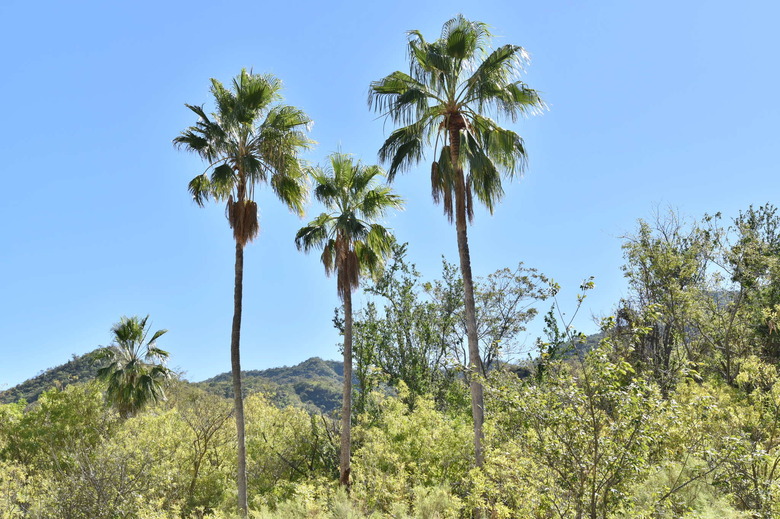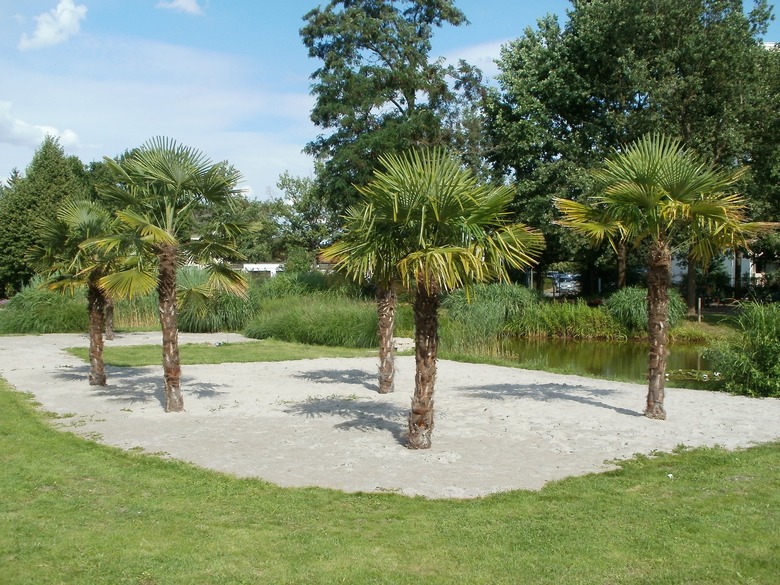Mexican Fan Palm Vs. Windmill Palm
The Mexican fan palm (Washingtonia robusta) and the windmill palm (Trachycarpus fortunei) are both species of palm with single trunks in the family Arecaceae. However, they are from different parts of the world and differ significantly in size and growth rate. They also differ in the appearance of the bark and the color of their flowers.
Let's go over some of the key characteristics of these two species of palm tree.
Mexican Fan Palm Tree
As its common name indicates, the Mexican fan palm is native to Mexico, though it has naturalized in parts of the U.S. with warm climates, including California, Hawaii, Florida and Texas.
As a tropical species, it is only hardy in U.S. Department of Agriculture hardiness zones 9 to 11. Its fronds will be damaged if it is exposed to temperatures of 20°F or colder.
Tip
Mexican fan palms are desert plants that are damaged by cold temperatures.
The Mexican fan palm, as you may deduce from its botanical name, is an extremely tall palm, with heights between 50 and 100 feet. This fast-growing tree can thrive in full sun or part shade.
Foliage
The fronds of this species are fan-shaped, with widths between 3 and 5 feet. The petioles may be 4 to 6 feet long and are covered in sharp teeth.
Mexican fan palms that are less than 30 years old usually don't shed their old fronds; instead, these dead leaves droop down and form what resembles a dense skirt around the trunk. These dead fronds can pose a fire hazard and should be removed. Eventually, however, the tree will "self-clean" and shed dried fronds on its own.
Trunk
The trunks of Mexican fan palms are a reddish-brown color. With time, the trunks become light gray.
Flowers
The Mexican fan palm blooms in June, when it produces conspicuous clusters of cream-colored flowers that extend beyond the leaves and droop downward.
Windmill Palm Tree
The windmill palm tree is native to China. It is a much smaller tree in comparison to the Mexican fan palm, with typical heights between 20 and 40 feet in its native habitat. In cultivation, however, it usually has heights between 8 and 10 feet.
Compared to the Mexican fan palm, this tree has a very slow growth rate and can be grown in containers.
Tip
The windmill palm is a much smaller tree than the Mexican fan palm.
In addition, unlike the Mexican fan palm, the windmill palm is one of the most cold-hardy palms, as it can survive winter in USDA hardiness zones 7 to 11 and withstand temperatures as low as 10°F.
The windmill palm tree grows best in partial shade.
Foliage
Like the Mexican fan palm, the Chinese windmill palm has toothed petioles and fan-shaped fronds. The fronds extend in all directions, which is why this tree is said to resemble a windmill.
Trunk
The trunk of a windmill palm is quite different than that of a Mexican fan palm. The trunks of palms of this species are a dark gray color and covered in hairy fibers.
Flowers
In June and July, the windmill palm produces clusters of flowers. The flower color of this species is yellow.


